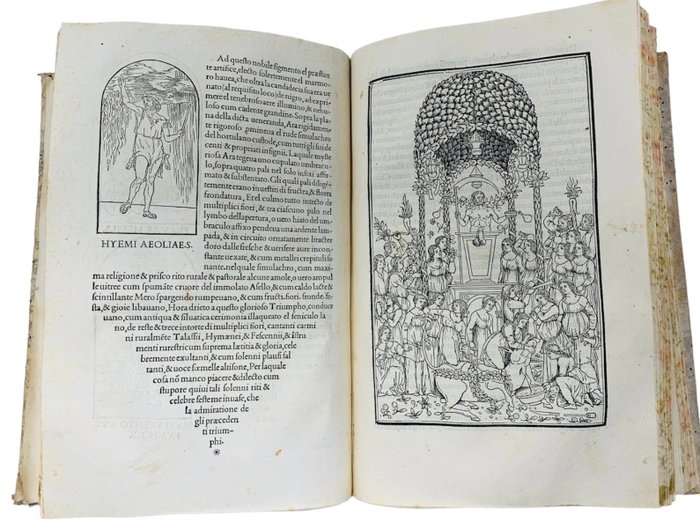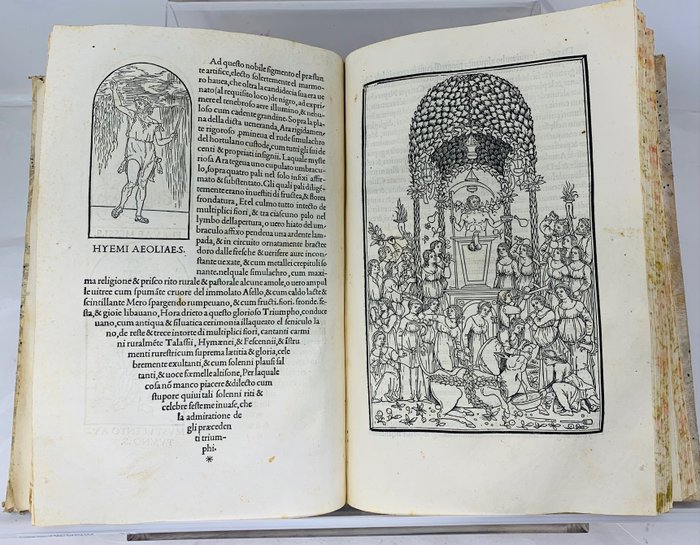Advert Description
Are you interested in this item? This item is up for auction at Catawiki. Please click on "respond to advert" (orange button) to get redirected to the Catawiki website. Catawiki’s goal is to make special objects universally available. Our weekly auctions feature thousands of unusual, rare, and exceptional objects you won’t find in just any store. COLONNA, Francis. Hypnerotomachia Poliphili ubi humana omnia non nisi omnium esse docet atque obiter pluria scitu sane quam digno commemorat. (At the end:) Venetiis, mense decembri MID in aedibus Aldi Manutii, very accurate.
In folio (277x184 mm). Cc. [222 of 234, missing the 12 ff. +1, +4, a1, a8, c8, y8, d2, d7, d8, f1, f3 and f4. The volume is illustrated by 168 woodcuts of which 10 full-page – therefore only 4 are missing, including a diagram – attributed to the Paduan miniaturist Benedetto Bordone: The famous wood of Priapus is not censored, as are 34 (out of 39) large decorated initials . Message annotations by several hands of a later period, on f. z10r long text “De purpureae rosae laude”, unidentified. Genuine copy with still crunchy paper, still attractive despite some light stains and foxing, a marginal hole on ff. 1-2, two ff. browned leaves, woodworm holes on the last f., reinforcement on the inner margin of the last f. The most famous illustrated book of the Renaissance: albeit slightly incomplete of a dozen sheets, it represents the myth of the activity of Aldo Manuzio. The "Battle in Poliphilo's dream" remains the real dream of every bibliophile.
17th-century full vellum binding, elegant double insert on the spine with gold-embossed title and place and date of printing, marbled endpapers, green silk bookmark (missing on spine and caps, damaged corners).
First edition of this famous and precious illustration, estimated among the most beautiful books of all times, a true literary and typographical masterpiece of Humanism. ''The combination of drawing and written text therefore proves to be fundamental, infinitely more important than in most illustrated books, in which the drawings are substitutes for the written. Here illustration and writing found themselves united in the act of conceiving the work, in the pretextual generative phase.''; in this sense the Aldean masterpiece anticipates by 4 centuries what will be the conception of the twentieth century ''livre d'artiste''. The work was reprinted in 1545 with the title in Italian ''La Hypnerotomachia di Poliphilo, that is love fight in a dream. Where he shows that all human things are nothing but a dream: & where he narrates many other things worthy of knowledge'': ''It is a simple reprint of the previous one, with some attempts at corrections. The original woodwinds are repeated in their entirety, except for eight which were replaced; the fonts are slightly smaller and the abbreviations different; partly changed the orthography to comply with the new linguistic rules now established; corrected the most serious printing errors.''. First detached bifolio, scattered halos, small marginal hole on ff. c and c2 s, leaves e1 and e8 burnished, ancient woodworm hole reinforcements in the inner margin of the last f. Al f. z10r long note ms. with a Latin text entitled "De purpureae rosae laude", which we could not identify. The copy does not have any of the variants identified by Neil Harris in the Gutenberg Jahrbuch of 2006. First edition of the most famous illustrated book of the Renaissance, probably the pinnacle of Aldus Manuzio's typographic production. Usually attributed on a documentary basis to the Dominican friar Francesco Colonna, the Dream of Poliphilus represents one of the most bizarre and controversial works of our literature. In the first place, for the language, a mix of Latin and vernacular with a northern inflection, interspersed with frequent Greek and Hebrew words. Secondly, for the text, at times obscure, full of descriptive digressions and strongly allegorical, which narrates Polifilo's initiation to sensory and intellectual knowledge.
RENOUARD P. 21.5. ESSLING I, 1198. SANDER I, 2056. ADAMS C-2414. IGI 3062. BMC V, 561. GOFF C-767. POZZI-CIAPPONI, EDIZ.CRITICA, 1980. M. Calvesi, The fight of love in a dream by Francesco Colonna from Rome, Rome, 1996; L. Lefaivre, Leon Battista Alberti's “Hypnerotomachia Poliphili': Recognizing the Architectural Body in the early Italian Renaissance, Cambridge (MA), 1997; M. Lowry, The World of Aldus Manutius. Oxford, 1978, p. 118-125; N. Harris, Nine Reset Sheets in the Aldine “Hypnerotomachia Poliphili' (1499), in: “Gutenberg-Jahrbuch”, 2006, pp. 245-275; M. Palumbo, Benedetto Bordon, a Life in the World of Books, New York, 2015, pp. 16-27 and no. 10.
NOT YET PROVIDED WITH A CERTIFICATE OF FREE CIRCULATION, THE SHIPPING TIMES FOR ABROAD ARE SUBJECT TO THE TIMELINES OF OBTAINING THE DOCUMENTATION 67217733





